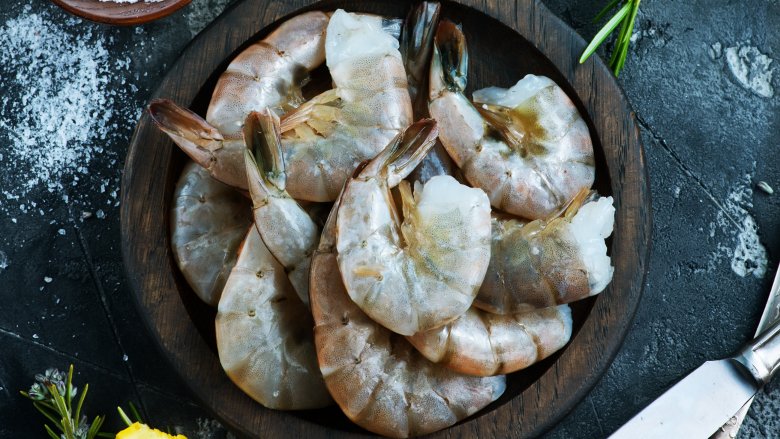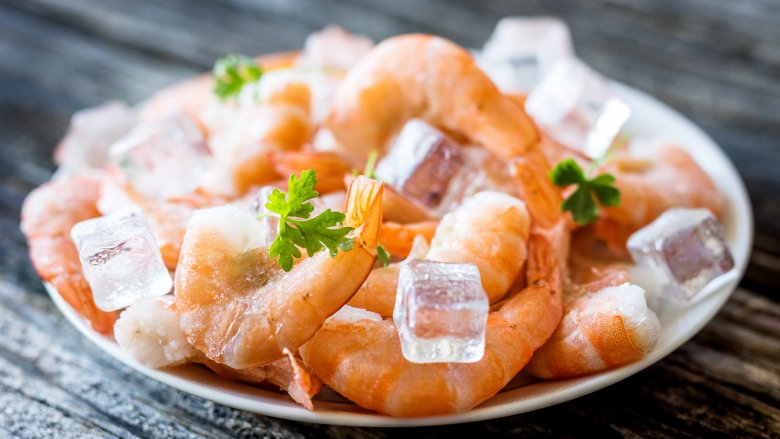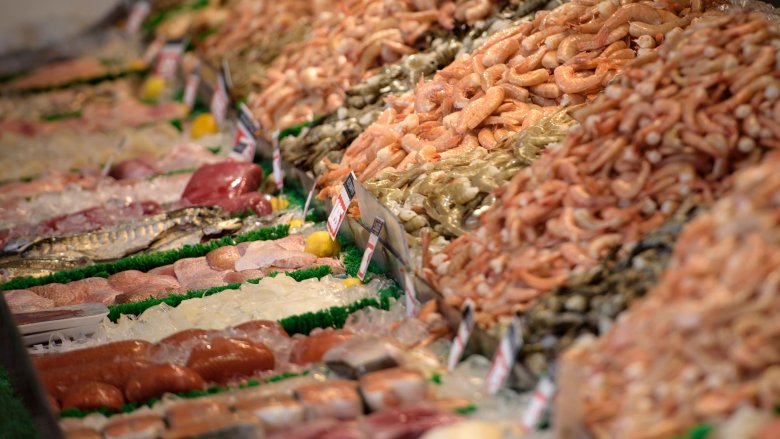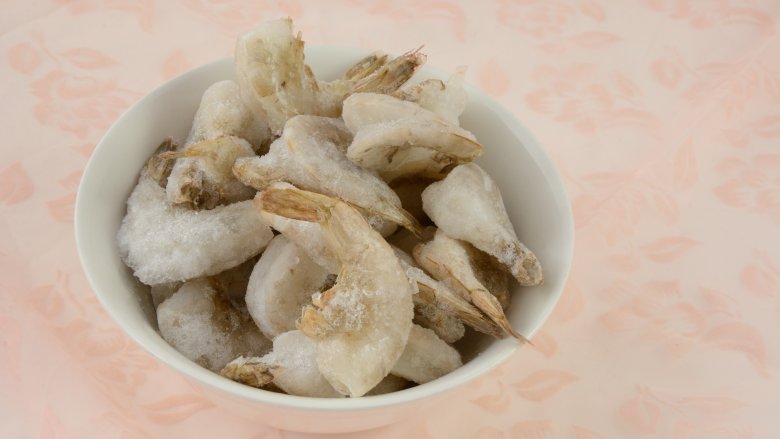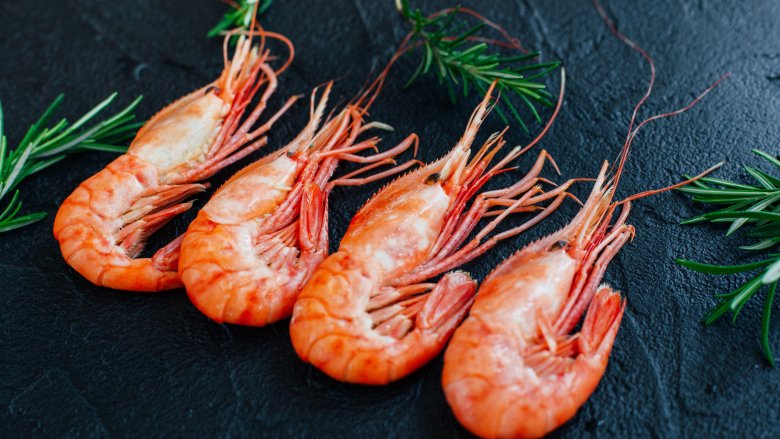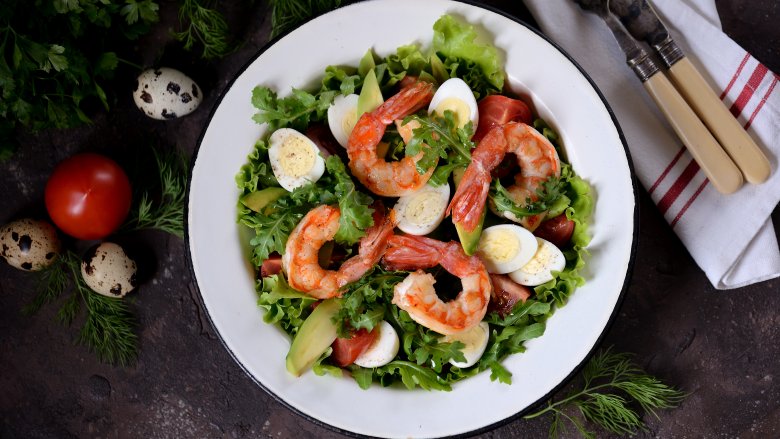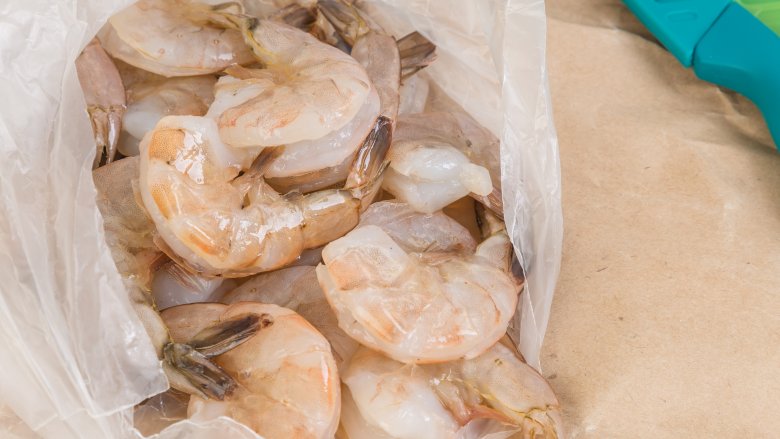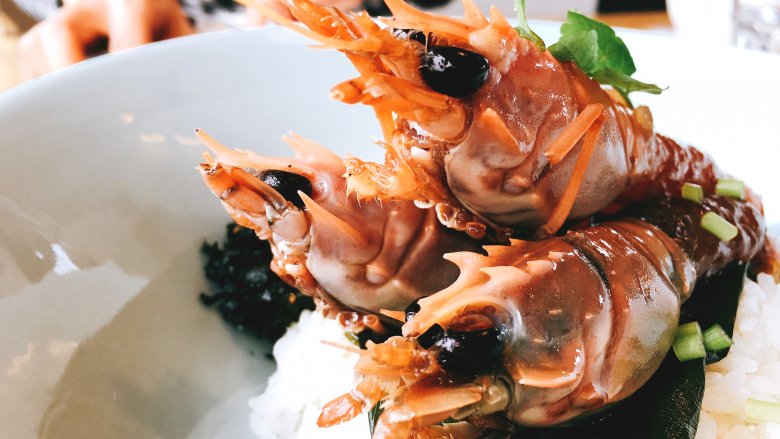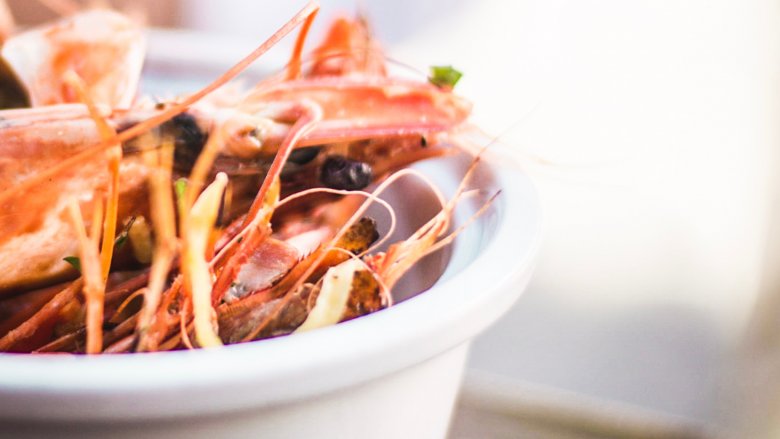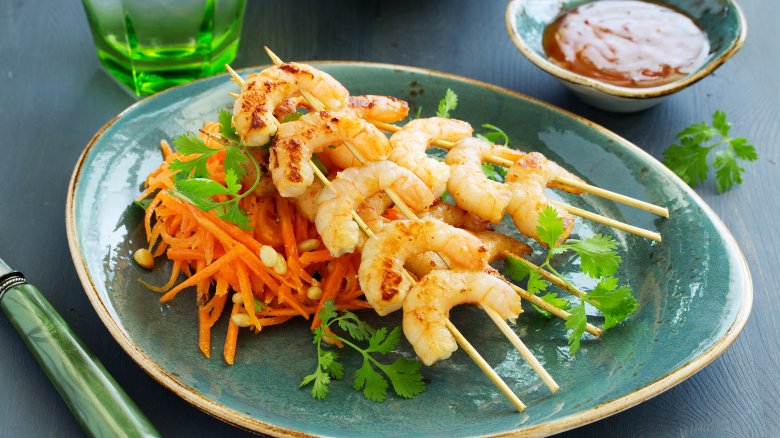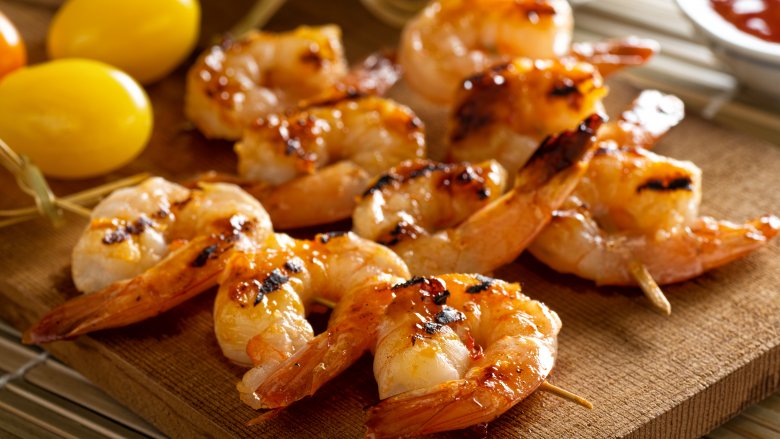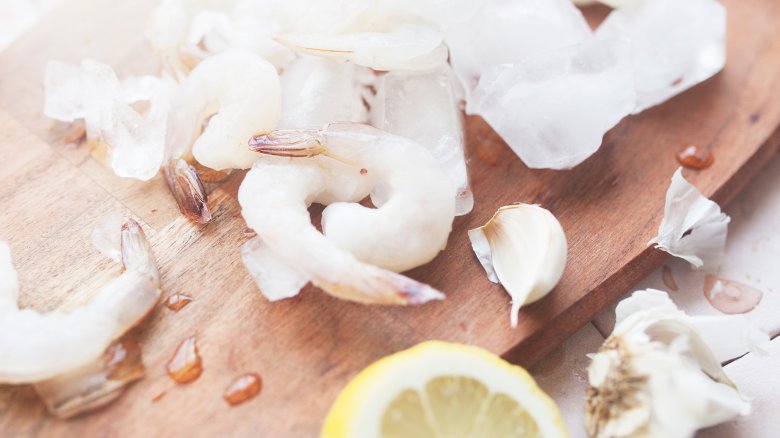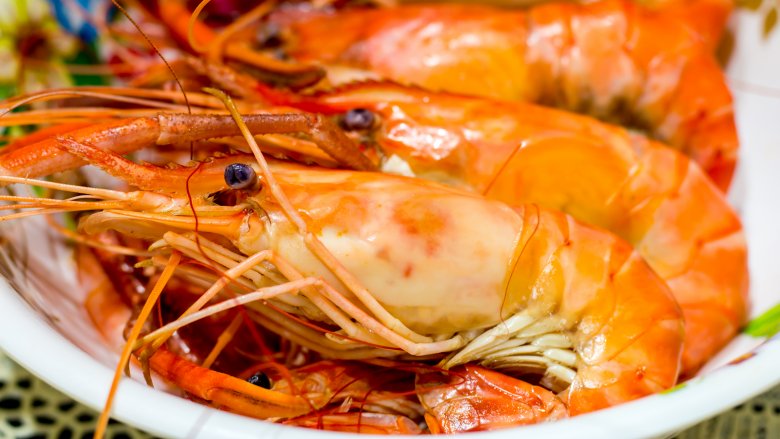Everything You Need To Know About Cooking Shrimp
If you love shrimp, you probably feel like you don't get it often enough. It seems as though it's something a lot of us leave for special occasions or — even worse — never even cook at home. That "special occasion" label might mean you tend to think it's too much of a pain, it's too time-consuming, and it takes too much planning to make it to the store, buy fresh, then prep, cook, and eat it all in the same night. Put it that way, and it does sound like a lot of work.
But it's not! Or, at least, it doesn't have to be. Cooking shrimp is less intimidating and time-consuming than you might think, so let's talk about why. There are some super-easy steps you can take to make shrimp so convenient you might just decide to add a shrimp stir fry, shrimp tacos, or a shrimp and pasta salad to your weekly menu rotation. Let's break it down and make it easy!
Buy frozen
You hear it all the time: Frozen food shouldn't be your first choice. While that's definitely true for a lot of things, it's not at all true for shrimp... most of the time.
The Los Angeles Times took a look at the debate, and they say that if you hit the grocery store for your shrimp, you have two options: frozen and non-frozen. We'll start with the ones in the freezer section. They were caught, cleaned, and put through a process called individual quick freezing. Grab a bag or two of these and you can take them home, thaw as you need them, and you have shrimp that's almost as good as fresh.
Now, let's look at the shrimp on the fish counter. There's a good chance that was previously frozen in the exact same way in order to keep it fresh for transport, then thawed before it was put on display. There's a completely legitimate reason they do it, and that's simply because shrimp goes bad so fast. But that also means that unless you live in a region where you can get truly fresh shrimp on the same day they're caught, buy frozen.
Signs you've waited too long
Using the freshest shrimp possible is key to putting out a delicious — and safe — dinner, and there are a couple things you should look for while you're prepping and cooking. Shrimp that's starting to develop black (or, depending on the type, pink) spots on the shell should be tossed, as those spots are an indication they weren't handled and iced properly from the source. Odd smells — like ammonia, chlorine, or sulphur — are also telltale signs that something's wrong, and if you think there's an odd texture to them, throw them out. Shrimp that are slimy, super dry, or mushy are definitely not ones you want on your plate, either.
Serious Eats shares another tip: If your shrimps still have their heads, they're going to go bad much, much faster than headless shrimp. If heads aren't removed immediately after they're caught, they'll start to degrade to uselessness in a matter of hours. It's something to watch out for, whether you're buying frozen or from a fresh fish market.
How to safely thaw
Thawing frozen food — any frozen food — can make or break the meal. Do it wrong, and you have something so close to being inedible it doesn't matter, and that might be one of the things keeping you from investing the money and time into frozen shrimp. But there's no need to worry, as thawing them properly is easy.
Fine Cooking says there are two ways you should be thawing your shrimp. If you can plan ahead, just put them in the fridge and let them thaw overnight. If planning in advance isn't your strong suit, that's all right. Take the shrimp out of their package, and put them in a bowl in the sink under a slow, steady stream of cold water. The circulating water will thaw them to the point they're ready to cook in about 15 minutes.
That said, you should also be aware that cooking partially-thawed shrimp isn't going to work, and neither is getting non-frozen shrimp, then taking them home and freezing them. Since they've probably already been frozen and thawed once before, you'll end up with a less-than-stellar dish, and no shrimp should suffer that indignity.
The case for cooking with the shell on
Even if you're not going to eat your shrimp shells (and Epicurious assures us they are, indeed, both edible and digestible), you might want to consider at least cooking them with the shell on. There are a few reasons for that, and Today says when you cook shrimp with the shell on, they'll come out plumper and with a more powerful flavor. If you're worried about the vein, you can probably find some shell-on frozen shrimp that have already been deveined, or you can just slice through the back of the shells and pull it out yourself.
Cookbook author Karen Frazier (via Love to Know) says there are a few other things to consider, particularly what kind of impact leaving the shell on or taking it off will have on the shrimp's final flavor. If you're grilling shrimp, leaving the shell on will help it retain a strong shrimp flavor, while taking it off will encourage the flavors of the smoke and the marinade. In the end, it's a judgement call based on what you want your final dish to taste like.
Tail, or no tail?
Sometimes you see shrimp served with the tail still on, and sometimes, it's been removed. There are some guidelines that might help you decide which way you should go, but remember — there's no right or wrong way here, either.
According to Bruce Mattel of The Culinary Institute of America (via Marketplace), there's a basic rule that it's all in the preparation. If you're going to be grabbing the shrimp and eating it by hand — think shrimp cocktail — leave the tail on as a handle. If the shrimp is going in another dish you're going to use a fork for — like stir-fry or a pasta — take the tail off.
Or... leave it on. You might decide to eat the tail, and it's not unheard of. Some people swear by the deliciousness of deep-fried shrimp tails, and others say it depends on the type of shrimp. Cooking shrimp with the tails on will add to your depth of flavor, so there's that to consider, too — just be aware that if you decide to leave them on for a pasta dish, you might end up with some annoyed diners.
Make deveining and peeling easy
If you avoid making shrimp yourself, it's probably because the idea of peeling and deveining them is equal parts intimidating and gross. There are a few tricks that make it pretty easy, though, and assuming you've decided to go shell-off, we'll start with peeling.
To easily peel the shell off, hold it with the underside up, and use your thumbs to crack through this softer section of the shell. Then just peel it off! If you have a pair of kitchen shears handy, you can also cut through the top of the shell — the hardest part — and peel it off that way, too.
According to Nobu Dallas chef Victor Clay (via Bon Appetit), removing the vein is easy when you use that second method. As you're prepping, he says to just split open the shell and go through the shrimp's back, running it under cold water while you're doing it. The movement of the water loosens the vein and makes it easy to pull out, and he also says he can get through prepping around 20 shrimp a minute with the help of that simple technique.
Heads or no heads?
Even if you like shrimp, you have to admit the heads are a little off-putting. It's no wonder that most of the frozen shrimp you can buy already have their heads removed, but if you happen to get some of the fresh or head-on variety, there's no reason to just chop them off and throw them away.
The Concourse found if you can get past the appearance, leaving shrimp heads on is a completely legit way to make shrimp. Just coat them with some cornstarch and fry them up with veggies, and you'll find they're crunchy, salty, and come with a strong shrimp flavor you might just love. There is a catch, though. The American Shrimp Company recommends getting headless shrimp if you're just going to be removing them anyway, since (as we've already addressed) it just makes them go bad faster. Bottom line? If you're not a fan of the crunch, go headless.
Save extra bits
By "extra bits," we're talking about the shells and tails you remove, and you absolutely shouldn't throw those things away. Why? Because you can use them to make an amazing stock!
It's the same principle as using the carcass of a chicken or turkey to make stock for soup, and after you did that once, you never threw the bones away again, did you? It's easy to do, too. Just take all the extra bits you have left over, and simmer them for about 15 minutes in a pan filled with just enough water to cover your shrimp trimmings. Add seasonings if you like (but it's not necessary), and once your liquid has taken on a mild, orange-yellow color, your stock is done. Strain out the pieces, let it cool, and you can freeze it for use some time in the future.
The next question is: What do you do with it? Substitute for water in recipes you'd like to add a little shrimp flavor to — that can be anything from soups to pasta sauces, gumbo, or even grits. Pretty brilliant, right?
Do skewers right
Once you're out of school and summer vacations fade into a distant memory, summer tends to take on a whole new meaning. It's still exciting, just for different reasons. One of those reasons? Grilling!
Throwing some shrimp on the grill is a great way to add just a little bit extra to your backyard cookout, and there are a few tips that will make this much, much easier. First, go big or go home. Bigger shrimp are going to be much, much easier to skewer, especially considering our other tip is to use not one skewer, but two. Push one through the thickest part of the shrimp near the arch (imagine it's where the shrimp's shoulders would be), and the other through closer to the tail end. Call it the shrimp hips, maybe? Using two skewers means they're not going to rotate easily, like they tend to on a single skewer, and it'll make getting an even char that much easier. You won't even have to put down your beer to turn them!
Don't forget the marinade
Sure, you might love the taste of shrimp and think they can stand on their own, and they can. But letting them sit in some marinade before cooking them will take your meal to a whole new level.
There's a bonus here, too, and that's the fact that shrimp will absorb the marinade very, very quickly. You'll only need to let them sit for around 20 minutes, and you definitely don't want to leave them in much longer than that (via Food Network). That said, there's plenty of room to experiment. In the mood for something spicy? Try a marinade of honey, Sriracha, soy sauce, and lime juice. Ginger, soy sauce, lime juice, garlic, peanut oil, and onion are a great combination if you're looking for an Asian flair, or you can go super-easy with some coconut milk and lime. Experiment with dill and dijon mustard, lemon and garlic, cilantro and pineapple, or even throw in some mint. It's ideal for mixing up your meals without taking side trips to the grocery store, and everyone can get on board with that.
Know your shrimp safety
Get food poisoning from seafood once, and you'll never forget it. So, let's talk safety and first, the scary part. Consumer Reports tested around 500 pounds of shrimp from 27 different locations in 2014, and they found about 60 percent of raw shrimp contained enough bacteria to cause some serious food poisoning.
Now, the good news — there are some easy steps you can take to minimize that risk. It starts at the grocery store. Since shrimp is such a delicate food, wait until the very end of your shopping trip to pick it up, keep it cold on the way home, and put it away immediately. When you're cooking and prepping, go through the same steps of washing and rewashing you do when you're prepping something like chicken, and that will help stop cross-contamination.
They also say you shouldn't let the internal temperature of your shrimp rise above 40 degrees before you start cooking, and that means you're going to have to work quickly to do all that prep. Keep them cold while you prep, and if you're making stock from your shells, do that ASAP. Don't let anything sit, keep everything clean, and you'll minimize your risk.
Get creative
Shrimp cocktail or shrimp scampi, it doesn't matter what your favorite shrimp dish is — there's always room for a new favorite. Once you're comfortable with the process of thawing, cleaning, and prepping shrimp (and it really is easier than you think, we promise), there's always room for experimentation.
There are a ton of different things you can do with shrimp — so many, in fact, that we wrote an entire piece on it that you can check out here. Get the low-down on boiling, grilling, on shrimp and grits, on roasting, on making soups and stews, on breading, on shrimp ceviche, and on shrimp cocktail. There's a built-in bonus with shrimp, too. As much as you might love food, going grocery shopping is always something of a chore. Don't think of it that way any more — think of it as an excuse to pick up some shrimp on your way out of the store, and to treat yourself and your family with some delicious — and creative — shrimp-based meals.
